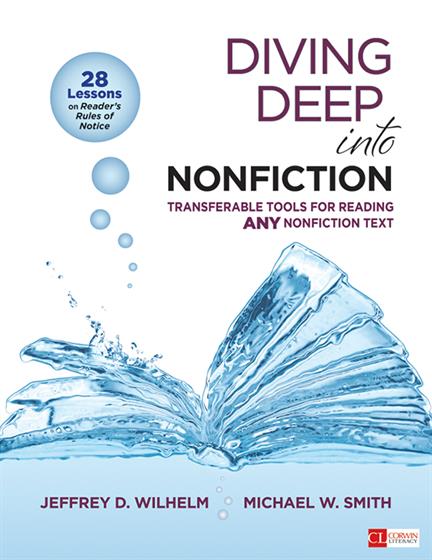LIST OF VIDEOS
ACKNOWLEDGMENTS
1. Reader’s Rules of Notice
What Skilled Readers Do
What This Noticing Means for Us as Teachers
Principles of Effective Instruction
The Current Educational Climate
How This Book Works
How to Use This Book
2. Noticing the Conversation
Lesson 1. Noticing the Conversation: Reading Visual Texts
Handout 2.1. Beer Street and Gin Lane
Handout 2.2. Two Views of Children’s Play
Lesson 2. Noticing the Conversation: Thinking Aloud
Handout 2.3. Intelligence: A Brief History (Excerpt) by Anna T. Cianciolo and Robert J. Sternberg
Lesson 3. Noticing the Conversation: Practice in Miniature
Handout 2.4. Noticing the Conversation
Handout 2.5. More Practice Noticing the Conversation
Lesson 4. Noticing the Conversation: Questioning
Handout 2.6. Narrative of the Life of Frederick Douglass, an American Slave, Written by Himself (Excerpt)
Lesson 5. Noticing the Conversation: Writing and Responding
Lesson 6. Noticing the Conversation: Search and Find
Lesson 7. Noticing the Conversation: Putting It All Together
Handout 2.7. The Gettysburg Address by Abraham Lincoln
3. Noticing Key Details
Lesson 1. Noticing Key Details: Reading Visual Texts
Lesson 2. Noticing Key Details: Thinking Aloud
Handout 3.1. The Great Fire (Excerpt) by Jim Murphy
Lesson 3. Noticing Key Details: Practice in Miniature
Handout 3.2. Movie Review: Avengers: Age of Ultron (Excerpt) by Cary Darling
Handout 3.3. Harriet Tubman: Conductor on the Underground Railroad and Narrative of the Life of Frederick Douglass, an American Slave, Written by Himself (Excerpts)
Lesson 4. Noticing Key Details: Questioning
Lesson 5. Noticing Key Details: Writing and Responding
Handout 3.4. Mentor Sentences Based on The Great Fire (Excerpt) by Jim Murphy
Lesson 6. Noticing Key Details: Search and Find
Lesson 7. Noticing Key Details: Putting It All Together
4. Noticing Varied Nonfiction Genres
Lesson 1. Noticing Varied Nonfiction Genres: Reading Visual Texts
Handout 4.1. Thinking About Photographic Portrait Genres
Lesson 2. Noticing Varied Nonfiction Genres: Thinking Aloud
Handout 4.2. Sample Abstract: “Which AA Battery Maintains Its Voltage for the Longest Period of Time?” by Student Author
Lesson 3. Noticing Varied Nonfiction Genres: Practice in Miniature
Lesson 4. Noticing Varied Nonfiction Genres: Questioning
Handout 4.3. Letters to the Editor
Handout 4.4. Letters of Recommendation
Handout 4.5. Using Genre Knowledge to Evaluate a Text
Lesson 5. Noticing Varied Nonfiction Genres: Writing and Responding
Lesson 6. Noticing Varied Nonfiction Genres: Search and Find
Lesson 7. Noticing Varied Nonfiction Genres: Putting It All Together
Handout 4.6. Lincoln’s Second Inaugural Address
Handout 4.7. Kennedy’s Inaugural Address
5. Noticing the Text Structures in Nonfiction Texts
Lesson 1. Noticing the Text Structures in Nonfiction Texts: Reading Visual Texts
Lesson 2. Noticing the Text Structures in Nonfiction Texts: Thinking Aloud
Handout 5.1. Noticing Comparisons: Camping
Handout 5.2. Noticing Comparisons: Class Election
Handout 5.3. Noticing Comparisons: Spring Dance
Lesson 3. Noticing the Text Structures in Nonfiction Texts: Practice in Miniature
Handout 5.4. Noticing Comparisons: More Practice
Lesson 4. Noticing the Text Structures in Nonfiction Texts: Questioning
Lesson 5. Noticing the Text Structures in Nonfiction Texts: Writing and Responding
Handout 5.5. Cuing Comparisons
Lesson 6. Noticing the Text Structures in Nonfiction Texts: Search and Find
Lesson 7. Noticing the Text Structures in Nonfiction Texts: Putting It All Together
Handout 5.6. “Troposphere” (Excerpt) by Bill Bryson
Handout 5.7. Hillocks Hierarchy Questions
6. Why This Method Works
Motivating Deep Learning
Developing Cultural, Critical, and Identity Literacies
A Final Word
APPENDIX: GENERAL READER’S RULES OF NOTICE FOR NONFICTION
WORKS CITED
INDEX




